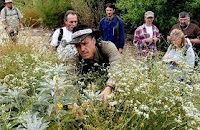Christopher Nyerges (Wild Plants — Foraging by the Season: SUMMER, Saturday, June 18, 2022, 10:00 AM | Meetup); Ananda (Dharma Buddhist Meditation), Wisdom Quarterly
Summer Foraging in the West: What are the seasonal greens, nuts, seeds, berries, roots, and so on that are available now around Los Angeles?
Seasonal foraging occurs once per season. We can learn to see nature through the seasons from a forager’s perspective. The essence of this class is to develop seasonal knowledge and observational skills:
Where to look, hot to look, and what to look for are important. We will also focus on responsible and sustainable gathering methods, including collection of seeds and cuttings so we can grow plants in our own yards. See web site for details.
Learn how to identify and collect foods, medicines, soaps, fire-materials, and other useful parts of plants. Learn to think like a forager of the past, who had to have an intimate knowledge of the seasons and foresight to know what would be needed later. For example, sometimes we do NO foraging in an area if plants and seeds are not abundant.
Join each quarter for an insightful walk into a wild area, with a focus on interpreting what’s available that season. Each session includes demonstrations, hands-on practice, and sampling of the seasonal foods, such as a foraged salad, soup, biscuit, or tea.
Each session includes a list of what is normally available that season.
SUMMER
At this time of year, there has usually been no rain for a while, so the environment is dry. Most of the early spring vegetation is gone. However, there are greens that develop later and are therefore typically found in summer, such as purslane and lamb’s quarter.
This is also a time to collect many fruits, such as wild cherries, manzanitas, nightshades, and ceanothus berries, which are used for soap.
In late September we find that most prickly pears (cactus fruit) are ripening. Acorns are starting to mature. We’ll learn what’s in season in for the traditional “harvest” to collect things sustainably and responsibly.
It’s been hot and dry, but there are actually still many wild plants that are in season and can be collected, each of which we’ll explore one by one.
 Remember, wild plants have their season. Some only begin to sprout in the summer. Although summer is not as lush as other seasons that enjoy the rains, there are still plants that can be collected for soup, salad, deserts, and drinks.
Remember, wild plants have their season. Some only begin to sprout in the summer. Although summer is not as lush as other seasons that enjoy the rains, there are still plants that can be collected for soup, salad, deserts, and drinks.We’ll see these plants and learn how to prepare them through the seasons. Join for class and the conversation that follows.
LOCATION: Foothill canyon in the Angeles National Forest. Details sent upon registration.













































































































































































































































No comments:
Post a Comment